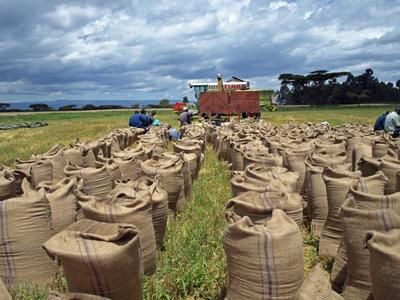You can also print a PDF of this lesson plan.
Food Insecurity is a complex and rising problem. It takes many forms, from food scarcity to lack of nutritious food. It plagues people around the globe, spanning continents and crossing borders. The same factors that cause food insecurity: the environment, economics and politics, are also the keys to solving the crisis. Since 2009, the Pulitzer Center on Crisis Reporting has reported on the many different aspects of food insecurity, from Guatemala to India and Vietnam to Kenya. These reports are collected in our special Global Gateway, Food Insecurity.
In this lesson plan students will:
- Be introduced to the concept of food insecurity
- Learn about what factors contribute to food insecurity
- How food insecurity has manifested in Nigeria, India and Guatemala
- Imagine a life very different than their own
Specific Subject Area Connections Science
- Ecosystems
- Effect of human activity on the Earth’s surface
- Environmental public policy
- Renewable and nonrenewable resources
Social Studies
- The impact of global trade on regional civilizations
- Political and social conditions of developing nations
- Modern-day conflicts
Student Preparation and Background Information
Have students think about and discuss the concept of food insecurity in small groups and then record their definition of food insecurity. Once students have brainstormed the concepts of food insecurity, have them review, or introduce the background information below.
The World Health Organization:
Have students visit the WHO’s website links provided below, to learn about how the WHO defines food security:
- Global Food Security Crisis – WHO response
- Food Security
Follow-up Questions:
- What are the three pillars of food security, according to the WHO?
- Is food security purely based on access to food? [Answer: no, also nutrition]
National Public Radio:
Have students listen to NPR’s radio broadcast, “Volatile Food Prices Grab G-20’s Full Attention,” By Eleanor Beardsley, KQED News, June 21, 2011, or read the accompanying article, that discusses the implications of volatile food prices worldwide.
Follow-up Questions:
- Why are politicians becoming more involved with the issue of food insecurity?
- The radio broadcast reports that many organizations predict food prices to double in upcoming years. If this happens, what do you think the political effects will be? What about the humanitarian effects?
Pulitzer Center Videos:
1. Nigeria
“Nigeria Families Left Hungry”
PBS Newshour, April 15, 2009, By Fred De Sam Lazaro
Questions:
- What type of food insecurity (lack of food or lack of nutrition) is the most prevalent in Nigeria?
- What factors foster food insecurity in Nigeria? [Possible answers: dry season, lack of government support, price instability]
- What conclusions can you draw about the role of government in ensuring food security from this video?
2. India
“India’s Growing Problem, Food Production”
PBS News Hour, September 14, 2009, By Fred De Sam Lazaro
Questions:
- What type of food insecurity (lack of food or lack of nutrition) is the most prevalent in India?
- How big a role does water availability play into food security in India?
- What impact will additional water pumps, dry season cropping, fertilizers, pesticides and other food insecurity solutions have on the environment?
3. Guatemala
“Guatemala’s Children Languish from Malnutrition”
World Focus, October 8, 2009, By Samuel Lowenberg
Questions:
- What type of food insecurity (lack of food or lack of nutrition) is the most prevalent in Guatemala?
- How does extreme poverty contribute to the food insecurity problem in Guatemala?
- What is stunting? How else does malnutrition affect children? How serious are the side effects of malnutrition?
Post-Videos Discussion: After your students have watched the videos, have them look back at their definitions of food insecurity. Have them discuss how accurate their definitions were, how close their conceptions of food insecurity were to the examples of food insecurity they saw in the videos?
Discuss with your students the main factors portrayed in the videos that contributed to food insecurity. Was it lack of government support, environmental degradation, lack of resources (water, seeds, fertilizer, ect), or poverty? Is it a combination of these factors? Which factors have the biggest impact?
Extension Activities:
1. Explore Food Insecurity in the United States
Ask your students if they think that the United States has problems with food insecurity.
- According to USDA’s Educational Research Service, about 14.7% of households were food insecure in 2009. (link to source) A major type of food insecurity in the United States comes from ‘food deserts’ or areas were populations don’t have access to fresh foods.
- Have your students explore the Center for Disease Control’s information on food deserts in America.
- Next, students have locate food deserts in your area by using USDA’s food desert map.
- Discuss the impact food deserts have on communities and the lasting problems they create. Have your students brainstorm some possible solutions.
2. RAFT Writing Activity
Role
Audience
Form
Topic
Aid Worker
Americans
Blog
Role of government in food security
Sustenance Farmer
Food insecure families
Newspaper Article
Chronic Malnutrition
Child
Your peers
Persuasive Essay
Environmental degradation caused by agricultural practices
3. Host an Awareness Event:
After watching these videos, and learning more about food insecurity in highlighted countries, your students may be interested in created an awareness campaign at school or within their home communities to publicize one of the issues covered through the Pulitzer Center reporting. This could be done through posters, a short video, or a “public service announcement” on the school’s morning news program or over the PA system.
4. Contact the Journalists:
If your students are interested in learning more about a topic explored in one of the videos in this lesson, the Pulitzer Center offers the opportunity for students to connect directly with journalists via email, Skype, or in-school visits. Go to journalist visits for more information.
| Attachment | Size |
|---|---|
| 72.56 KB |
